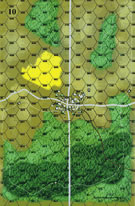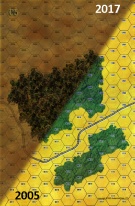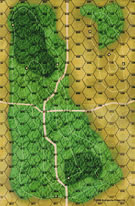|
Kurochkin's Attack Sinister Forces #23 |
||
|---|---|---|
| (Defender) Germany | vs | Soviet Union (Attacker) |
| Formations Involved | ||
|---|---|---|
| Germany |  |
3rd SS "Death's Head" Division |
| Soviet Union |  |
53rd Guards Rifle Division |

|
| Overall Rating, 1 vote |
|---|
|
4
|
| Scenario Rank: --- of 964 |
| Parent Game | Sinister Forces |
|---|---|
| Historicity | Historical |
| Date | 1942-08-11 |
| Start Time | 10:00 |
| Turn Count | 30 |
| Visibility | Day |
| Counters | 80 |
| Net Morale | 0 |
| Net Initiative | 2 |
| Maps | 3: 10, 6, 9 |
| Layout Dimensions | 84 x 43 cm 33 x 17 in |
| Play Bounty | 136 |
| AAR Bounty | 167 |
| Total Plays | 1 |
| Total AARs | 1 |
| Battle Types |
|---|
| Road Control |
| Urban Assault |
| Conditions |
|---|
| Off-board Artillery |
| Terrain Mods |
| Scenario Requirements & Playability | |
|---|---|
| Battle of the Bulge | Maps |
| Eastern Front | Maps + Counters |
| Sinister Forces | Base Game |
| Introduction |
|---|
|
In April, 1942, German attacks succeeded in opening a narrow corridor from the 16th Army front south of Staraya Russo to the II Corps surrounded around Demyansk. The Death's Head Division had spent the first months of 1942 within the pocket, and after the so-called "Ramushevo corridor" opened, moved into the line to help hold it against the expected Soviet counter-attacks. After some local attacks failed, Gen. P.A. Kurochkin of Northwestern Front planned a coordinated set-piece assault from both sides of the corridor, to isolate the Hitlerites again as the first step towards their destruction. First Shock Army, charged with attacking the southern flank of the corridor, did poorly on the assault's opening day. On the second day, it sent its second echelon slightly to the east against the SS men, known to be a depleted formation with a poor combat reputation. |
| Conclusion |
|---|
|
The Soviets attacked again and again, but made little progress thanks to their lack of artillery support. Both sides knew how vital it was to hold the Ramushevo Corridor, making surprise impossible. The 130th Rifle Division made some gains against the SS, the only place where the Germans gave ground, and held on despite repeated counter-attacks. After 10 days of heavy fighting, Kurochkin called off his attack. The STAVKA was not pleased. |
| AFV Rules Pertaining to this Scenario's Order of Battle |
|---|
| 3 Errata Items | |
|---|---|

|
The reduced direct fire value of the SS HMG is 5-5 in Beyond Normandy and Road to Berlin. (plloyd1010
on 2015 Jul 31)
|

|
The reduced direct fire value in Kursk: Burning Tigers is 4-4. (plloyd1010
on 2015 Jul 31)
|

|
Kommissars never get morale or combat modifiers. Ignore misprints. (Shad
on 2010 Dec 15)
|
| The Big Push that Almost Worked | ||||||||||||
|---|---|---|---|---|---|---|---|---|---|---|---|---|
The Germans had a lot of territory to cover with the units assigned to them. Taking advantage of the cover that the woods and the town gave them, they were to use delaying actions and superior OBA to slow down the Soviets, see how the battle developed, and take up a unified defensive position accordingly. The Soviets decided to hit the road in three groups: Battle Group West was to hit on the extreme left, cut the road, and swing east. Battle Group Center was to advance between the two westernmost hills and veer into the large hill on the right, forming pincers with BGW. Battle Group East, the main battle group, was to use the cover of the small central forest to get into position and hit the German positions across the road in the larger wood. They would then become the southern jaw of a pincer against the enemy positions further east and the town. The other two groups would form the northern jaw. Due to their overwhelming numbers, the Soviets did well in the opening moves, but were plagued with several problems: To begin with, a shortage of shells shut down Soviet OBA early in the engagement. However, the Soviet mortar teams, working together, did a masterful job of compensating. The German delaying actions did their job well. Their tactics were to draw the Soviets off the road and into the woods, slowing them down. Overall the horrific trading of lives for time threw the Soviets well off their timetable as they moved slowly through forest. Morale proved to be a major frustration for the Soviets. Their units were easily broken under even the lightest of small arms fire and were incredibly slow to rally. To add to the problem was an inept Kommisar, whose bungled attempts at rallying resulted in the loss of a half-step of HMG and a half-step of INF. At the end of the action, the Soviet forces had cleared the western and central sectors of the road. They pushed off in a well-coordinated move against the town. However, the surviving German troops maintained an orderly evacuation to the east. The Germans held final positions in town and in the field north of it, ready to hold those positions at all cost. But time ran out for the Soviets before it did for the Hitlerites. What started out as a successful push wound up as another hard-fought and bloody draw on the Eastern Front. A special commendation goes to SS Lt 6-0-0. Left to tend the mortars in the central woods, he went forward to efficiently move forward units to improved defensive positions. When it was time to leave the woods, he oversaw the orderly evacuation of his mortar teams as well as three infantry platoons. The end of the action found him spotting artillery in the woods south of the town. Recommended for firing squad are Kommisar 9 (see above), and the Soviet cavalry taking part in this action. Their cowardice under fire was a disgrace to the Soviet people and all military tradition. I don’t normally enjoy the longer engagements, but found this the exception to my rule. The VC’s and lay of the land can make for some interesting choices of tactics for both sides. |
||||||||||||
| 0 Comments |

 SiFo022
SiFo022 
























